|
Have a safe day!
Thursday, Jan. 26
2:30 p.m.
Theoretical Physics Seminar - Curia II
Speaker: Brian Shuve, Harvard University
Title: A WIMPy Baryogenesis Miracle
3:30 p.m.
DIRECTOR'S COFFEE BREAK - 2nd Flr X-Over
THERE WILL BE NO ACCELERATOR PHYSICS AND TECHNOLOGY
SEMINAR TODAY
Friday, Jan. 27
3:30 p.m.
DIRECTOR'S COFFEE BREAK - 2nd Flr X-Over
4 p.m.
Joint Experimental-Theoretical Physics Seminar - One West
Speaker: Huan Lin, Fermilab
Title: Gravitational Lensing and Cosmic Shear with the SDSS Coadd
Click here for NALCAL,
a weekly calendar with links to additional information.
Upcoming conferences |
|
Thursday, Jan. 26
- Breakfast: Apple sticks
- Santa Fe black bean soup
- Steak tacos
- Chicken Wellington
- Chimichangas
- Baked ham & Swiss on ciabatta roll
- Assorted sliced pizza
- Smart cuisine: Crispy fried chicken salad
Wilson Hall Cafe Menu
|
|
Friday, Jan. 27
Dinner
- French onion soup
- Medallions of beef with merlot sauce
- Potato gratin
- Steamed green beans
- Marzipan cake w/ bittersweet chocolate sauce
Wednesday, Feb. 1
Lunch
- Pork Schnitzel w/ noodles and browned cabbage
- Apple strudel w/ cinnamon cream
Chez Leon Menu
Call x3524 to make your reservation. |
|
Congressional tour of accelerator R&D facilities
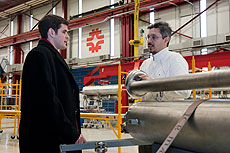 |
| Andrew Adair, Legislative Correspondent for Senator Mark Kirk, toured the SRF technology facilities in the Industrial Center Building on Jan. 20. Tug Arkan, SRF Department in TD, guided Adair through the inventive and inspired research Fermilab is conducting.
Photo: Reidar Hahn |
|
Condo for rent with lake view; feathered tenant preferred
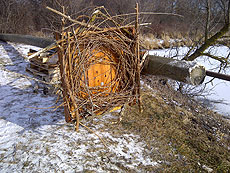 |
|
This platform, prepped for an osprey or bald eagle renter with sticks, was hoisted high in the air near Nepese Marsh on the east side of Fermilab. Photo: Dave Shemanske, FESS
|
Fermi Natural Areas and Thorne Electric of Carol Stream situated a bird nesting platform at Nepese Marsh on the eastern side of the Fermilab site. Volunteering their services, FNA and Thorne Electric personnel hope that the structure will attract a pair of large birds of prey to nest.
Data suggest that osprey fledglings tend to stay within a couple miles of where they were born. Presently, there is a nesting pair of osprey on the western side of Fermilab's site. They have produced young, one of which may be the future tenant of the Nepese Marsh platform.
There are also bald eagles nesting on Randall Road in Batavia, which is a short flight. Perhaps, if the nesting platform does not interest an osprey, an eagle will take up residence in the coming months.
The platform was a joint effort by laboratory employees volunteering their time to complete various stages of the project, and Tom Eggleston, of the Housing Office, built the nest structure from scrap wood. Hopefully, a feathered friend will move in by spring.
—Dave Shemanske, FESS
|
Fermilab restores savannas, helps wildlife
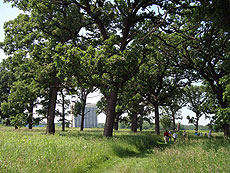 |
|
Fermilab's iconic Wilson Hall can be seen in the background as visitors inspect savanna restoration efforts. Credit: Fermilab Natural Areas.
|
Editor's note: One of the bonuses of Fermilab having much of its scientific infrastructure underground is that it allows for a wealth of open space on the 6,800-acre campus. Fermilab and volunteers from neighboring communities use that space to create havens of restored native habitats to help wildlife flourish. So far, more than 1,100 acres have been restored. Savannas are just one example of these restoration efforts.
The highly endangered oak savanna was once one of the most common vegetation types in the Midwest. Grant money from the DuPage Community Foundation is helping to save this natural gem for hikers and animals by supporting restoration efforts at Fermi National Accelerator Laboratory.
In December, the Foundation awarded $7,500 for oak savanna restoration to Fermilab Natural Areas, a not-for-profit organization consisting of volunteers from the Chicagoland area.
The money will help protect a 35-acre savanna remnant in the center of Fermilab, which straddles the border of Kane and DuPage counties.
The restored savannah will create a tool for educating school and community groups about Illinois' environmental past and the need for conservation. The savanna also should attract more wildlife to the area. Many infrequently seen species of insects and birds, such as the red-headed woodpecker, thrive in oak savannas.
The multi-phase restoration effort planned to start this winter will include removal of invasive species of trees and shrubs, prescribed burning, enrichment of the flora and monitoring. The project continues a long history of stewardship of environmental resources at Fermilab, which has led to the restoration of more than 1,100 acres of prairie, woodland, grassland and wetland.
Read more
|
A quantum speed limit: how fast does quantum information flow through a lattice?
From ars technica, Jan. 25, 2012
The speed of light is the cosmic speed limit, according to physicists' best understanding: no information can be carried at a greater rate, no matter what method is used. But an analogous speed limit seems to exist within materials, where the interactions between particles are typically very short-range and motion is far slower than light-speed. A new set of experiments and simulations by Marc Cheneau and colleagues have identified this maximum velocity, which has implications for quantum entanglement and quantum computations.
In non-relativistic systems, where particle speeds are much less than the speed of light, interactions still occur very quickly, and they often involve lots of particles. As a result, measuring the speed of interactions within materials has been difficult. The theoretical speed limit is set by the Lieb-Robinson bound, which describes how a change in one part of a system propagates through the rest of the material. In this new study, the Lieb-Robinson bound was quantified experimentally for the first time, using a real quantum gas.
Within a lattice (such as a crystalline solid), a particle primarily interacts with its nearest neighbors. For example, the spin of an electron in a magnetically susceptible material depends mainly on the orientation of the spins of its neighbors on each side.
Read more
|
|
Top quark mass team wages war on two fronts
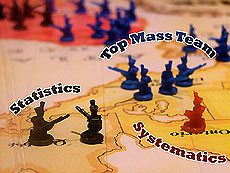 |
|
To improve the precision of the top quark mass measurement, physicists must contend with both statistical and systematic sources of uncertainty.
|
Two major factors contribute to the ultimate precision of a measurement of the top quark mass: the amount of data used to make that measurement and the understanding of the uncertainty introduced by the detector. The amount of data used affects the size of the statistical uncertainty of the measurement, while accounting for the bias of the detector effects leads to the systematic uncertainty. Since the final precision of a measurement can't be smaller than the larger of these two uncertainties, it is possible to have a measurement that is limited by the systematics. A systematically limited measurement won't improve by simply taking more data. The most recent top quark mass measurement at DZero succeeded in turning a systematically limited analysis channel into a statistically limited one.
The top quark always decays into a W boson and a bottom quark. The W boson can decay into a neutrino and a charged lepton, such as an electron or muon, or into quarks. The major distinction between top quark pair analysis channels is the number of leptonic W boson decays allowed. In the dilepton channel, both W bosons decay leptonically and two neutrinos are produced. However, the incomplete reconstruction of neutrinos in the DZero detector leads to ambiguity when studying these top quark pair events. To account for this ambiguity, DZero physicists considered all possible values of the neutrino parameters to determine the value of the top quark mass that best fits the DZero data set.
The major source of systematic uncertainty for this measurement is the response of our calorimeter to the energy deposit from the spray of particles, or jet, produced by each bottom quark. A previous DZero top quark mass measurement in the single charged lepton channel performed a precise calibration of jet energy by making use of the jets produced by the W boson that decayed to quarks. To reduce their systematic uncertainty, the dilepton analysis team based their analysis on that precision calibration while carefully accounting for the differences that might arise from applying that calibration in their particular channel. The improved systematic uncertainty helps make this result the world's most precise measurement in the dilepton channel and has now switched this channel from being systematically limited back to being statistically limited. Since this result uses about half of the full DZero Run II data set, it will improve when the additional data is added.
—Mike Cooke
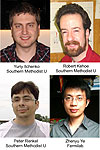 |
These physicists, along with Jason South, Southern Methodist University, and Huanzhao Liu, Southern Methodist University, made major contributions to this analysis.
|
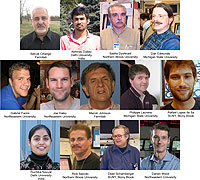 |
| This team maintained and monitored the operations of the DZero calorimeter and its contribution to the first stage of the triggering system that determined which proton-antiproton collisions were worth recording for use in analyses, such as the one above.
|
|
|